Understanding RV Air Conditioner BTUs
Basics of BTUs in RV Air Conditioners
When choosing an RV air conditioner, understanding the concept of BTUs (British Thermal Units) is essential. BTUs are a unit of energy that measures the amount of heat an air conditioner can remove from a space within an hour. In the context of RV air conditioners, the higher the BTU rating, the greater the cooling or heating capacity of the unit.
For RV owners, selecting the right BTU is crucial because an undersized air conditioner will struggle to cool or heat the interior, leading to inefficient performance and increased wear. Conversely, an oversized air conditioner may cool the space too quickly without removing enough humidity, leading to uncomfortable conditions inside the RV. It’s important to match the BTU rating of the air conditioner to the size and insulation level of your RV.
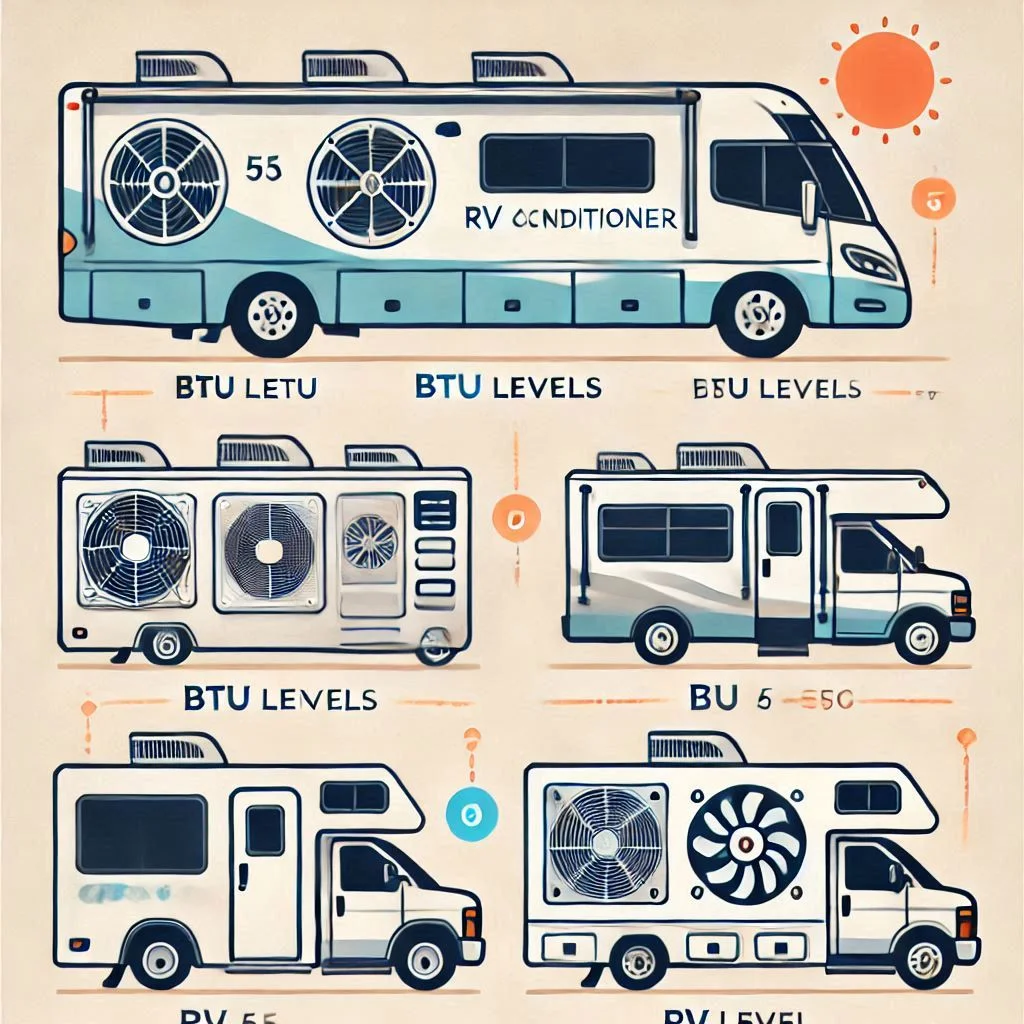
How BTUs Impact Cooling and Heating Performance in RVs
The cooling and heating performance of your RV air conditioner is directly related to its BTU rating. Here’s how:
- Cooling Capacity: A higher BTU rating means that the unit can remove more heat from the RV, effectively lowering the internal temperature. However, if the BTU is too high for the space, it will cool the air too quickly, leading to excess humidity. This can result in a damp, uncomfortable environment inside the RV. For example, a 13,500 BTU unit is ideal for a small RV, while a 15,000 BTU unit is suited for larger RVs or those in warmer climates.
- Heating Capacity: RV air conditioners also have heating capabilities, usually via a heat pump. The BTU rating plays a similar role in heating, where higher BTUs equate to more heat being generated. However, too high a BTU for the space can cause the RV to overheat quickly, making temperature control difficult.
Properly sized BTUs help maintain a comfortable environment inside the RV by ensuring the air conditioner operates efficiently without overworking or underperforming.
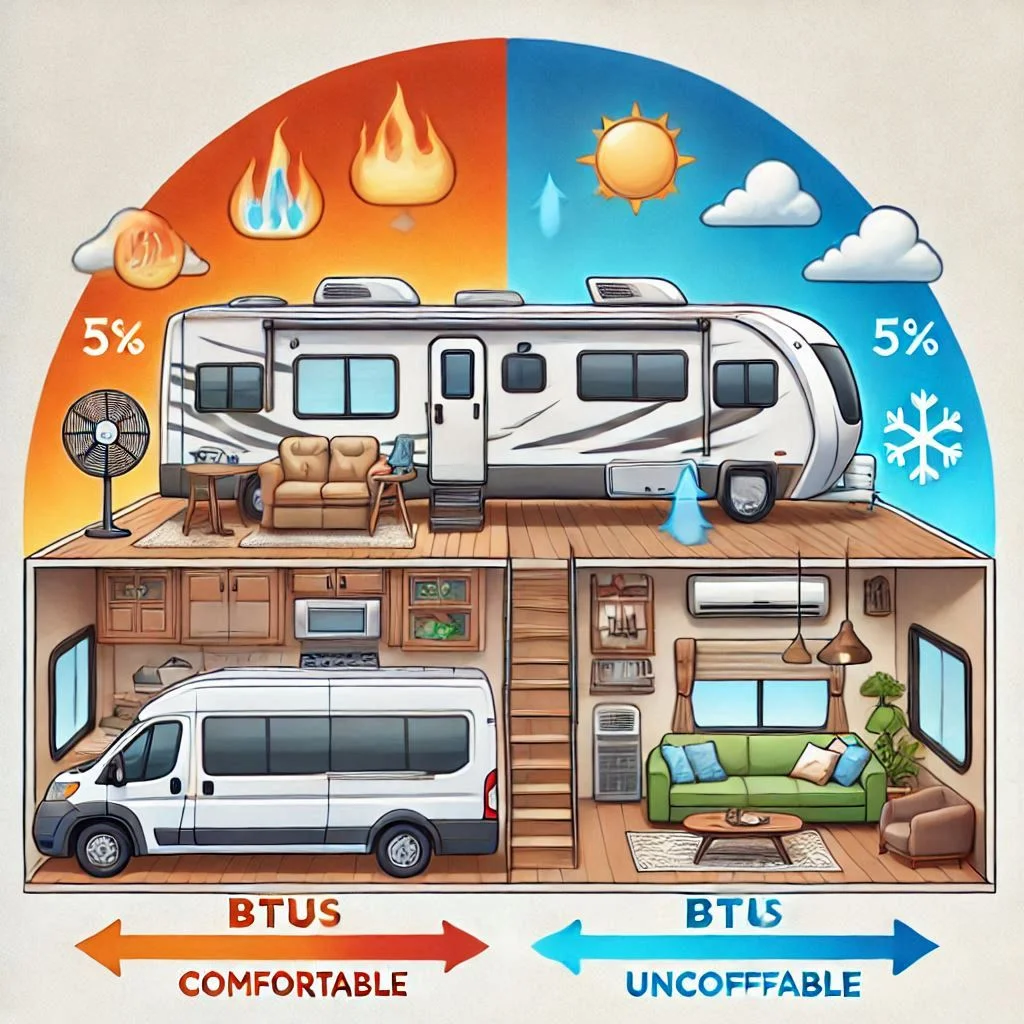
How to Determine the BTU Rating of Your RV Air Conditioner
To find out how many BTUs your RV air conditioner has, follow these steps:
- Check the Spec Sheet: Every air conditioner has a spec sheet that lists its BTU rating. Look for this information in the product documentation or on the unit’s nameplate.
- Unit Model Number: You can also determine the BTU by checking the model number of the air conditioning unit. Manufacturers often include this information as part of the model number, which can be cross-referenced online or with the manufacturer’s guide.
- Check Your RV’s Amperage: The amperage of the unit can also help determine the BTU rating. For instance, a 13,500 BTU air conditioner typically uses around 12-13 amps, while a 15,000 BTU unit may use about 13-15 amps. Comparing the power usage to the unit’s amperage can give you a clue about the cooling capacity.
- Ducted vs Non-Ducted Systems: Ducted systems generally require a higher BTU output because they are distributing air through ducts, while non-ducted systems direct air into the room directly. If your RV uses ducts, the unit will need more BTUs to circulate air efficiently throughout the space.
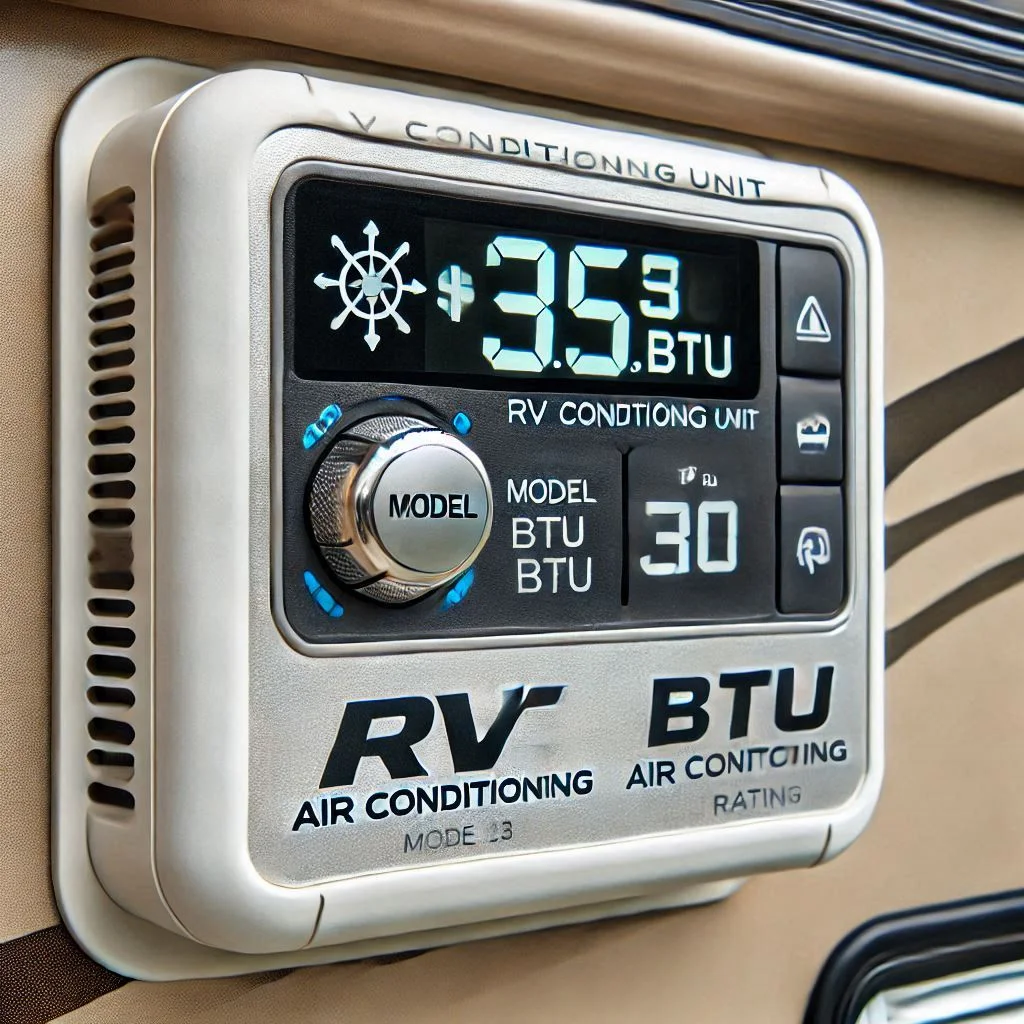
How to Determine the BTU Rating of Your RV Air Conditioner
Determining the BTU (British Thermal Unit) rating of your RV air conditioner is a critical step in ensuring that your cooling and heating needs are met efficiently. The BTU rating indicates the capacity of your air conditioner to cool or heat a specific area. Here are the key methods to determine the BTU rating of your RV air conditioner:
Checking the Spec Sheet
The spec sheet, or product manual, is the most reliable source of information when trying to find the BTU rating of your RV air conditioner. Manufacturers typically include detailed specifications, including the BTU rating, amperage, and other performance-related data.
- Why It’s Important: The spec sheet provides precise details about the capacity of the air conditioner, ensuring you understand the cooling and heating potential of the unit.
- How to Find It: You can find the spec sheet in the documentation that came with your RV or air conditioner, or you can look up the product information on the manufacturer’s website. If you purchased the air conditioner separately, the spec sheet may also be available on the retailer’s website.
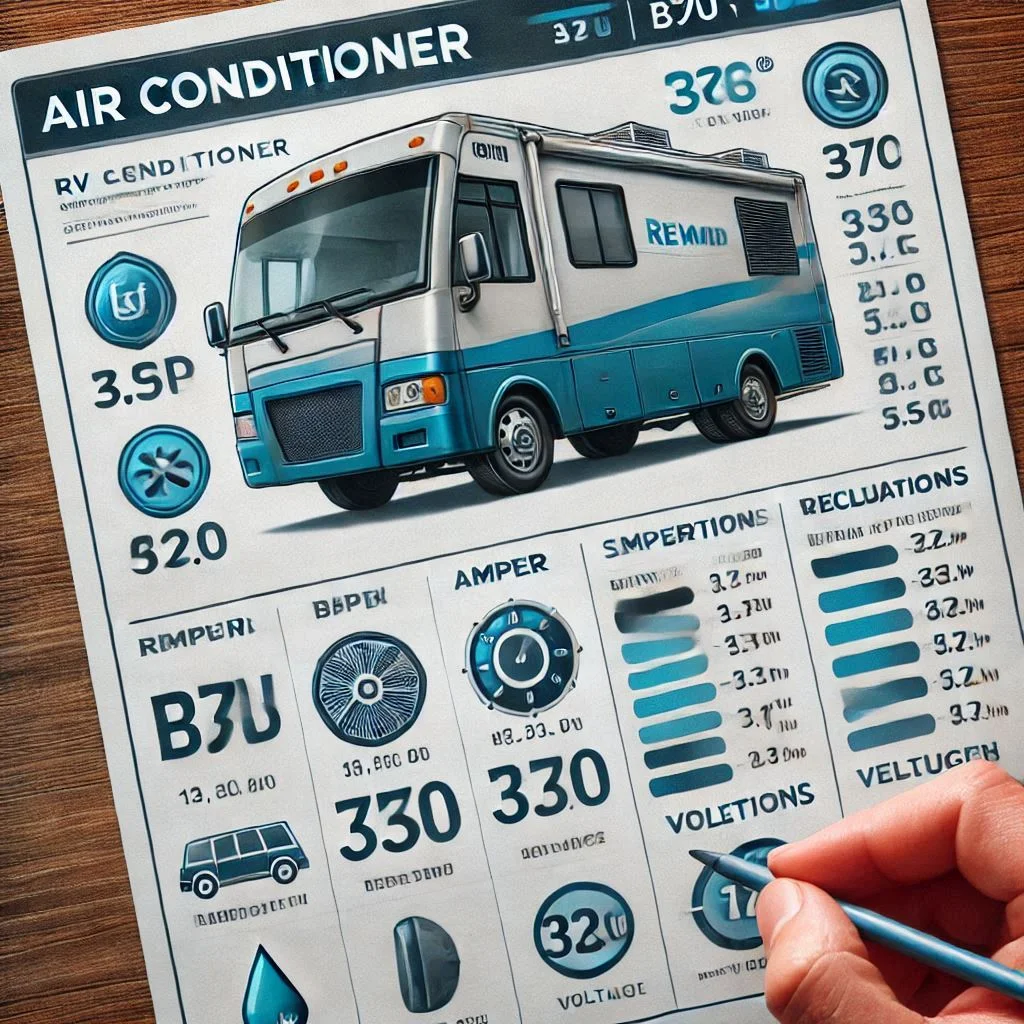
Finding the Unit Model Number
Another way to determine the BTU rating is by locating the unit’s model number. Air conditioners typically display the model number on a label or nameplate on the unit itself. This label may be on the side or top of the air conditioner, making it easy to find.
- Why It’s Important: The model number often includes details about the cooling capacity, which can be cross-referenced with the manufacturer’s database to identify the exact BTU.
- How to Find It: Look for a label or nameplate on the unit. The model number will likely be a series of letters and numbers, and in many cases, the BTU rating will be included in the format (e.g., 13,500 or 15,000).
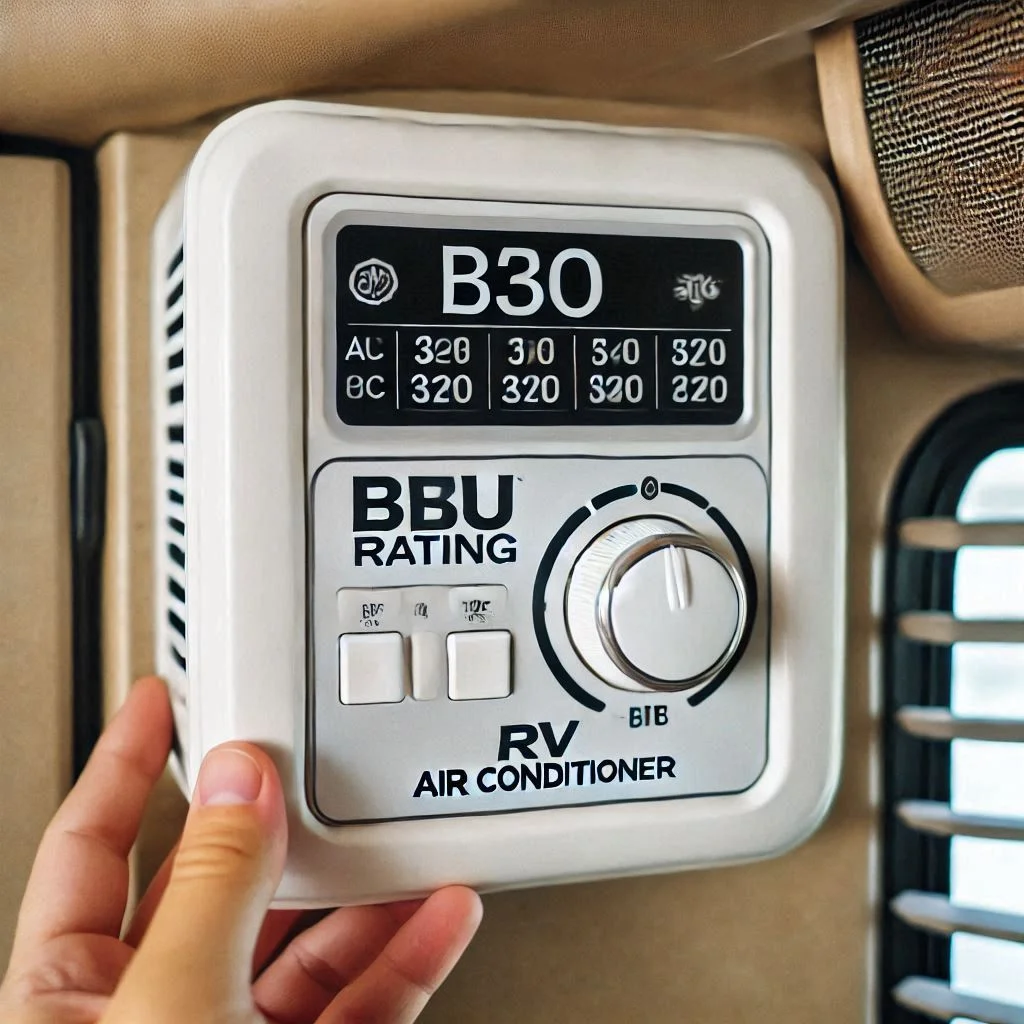
Verifying Amperage and Power Requirements
The amperage used by your RV air conditioner can also help determine its BTU rating. Air conditioners are rated in terms of the amount of electrical current they consume, which is measured in amps. Generally, the more amps an air conditioner uses, the higher the BTU rating.
- Why It’s Important: Understanding the amperage helps you choose the right power source and ensures that the air conditioner will function correctly without overloading the electrical system in your RV.
- How to Find It: Amperage is usually listed on the air conditioner’s nameplate or spec sheet. For instance, a 13,500 BTU unit typically uses around 12-13 amps, while a 15,000 BTU unit can require 13-15 amps. You can also check the electrical breaker panel in the RV to verify the amperage rating of the air conditioner.
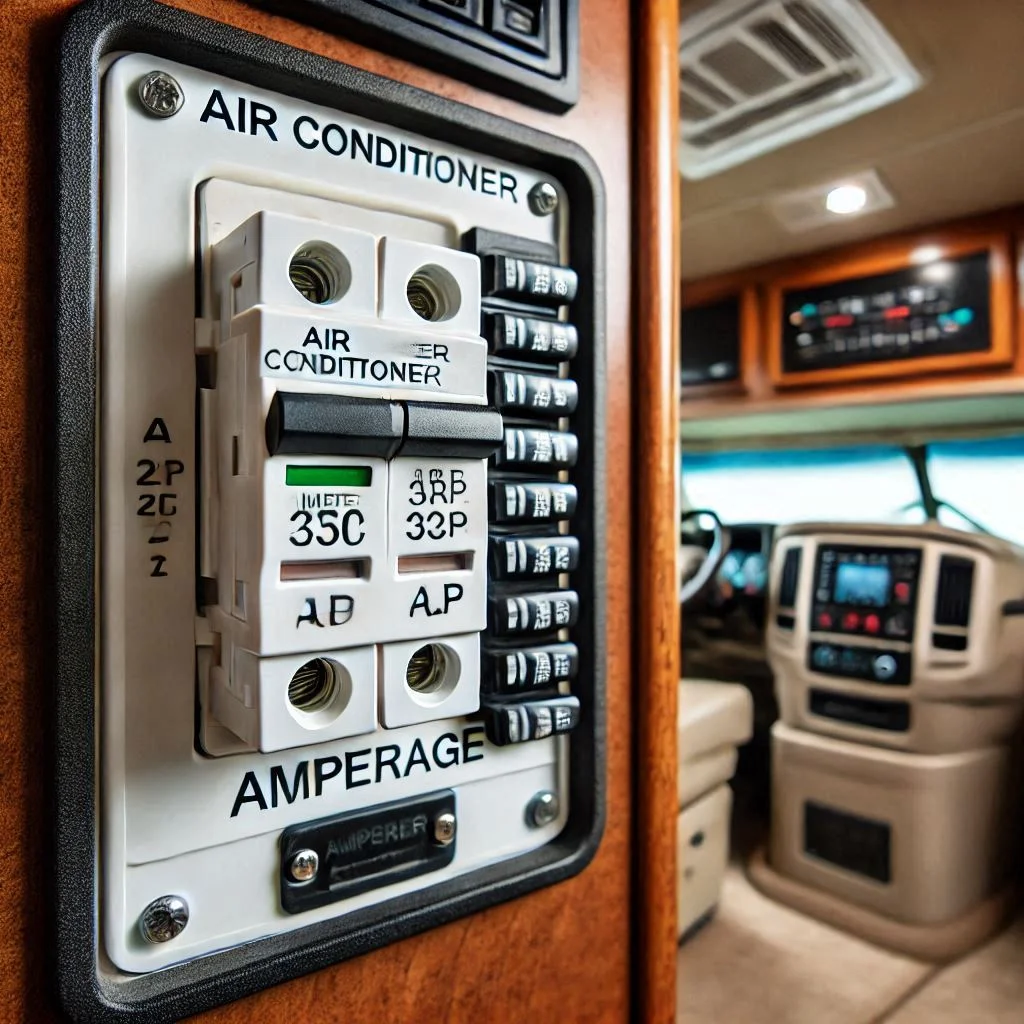
Ducted vs Non-Ducted Systems
Understanding whether your RV air conditioner is ducted or non-ducted is another critical factor in determining its BTU rating. Ducted air conditioners are designed to distribute air through a series of ducts, while non-ducted units blow air directly into the room. Ducted systems typically require a higher BTU rating due to the extra air distribution effort.
- Why It’s Important: Ducted systems generally require more power to distribute air throughout the RV, especially in larger units. A higher BTU will ensure adequate airflow and temperature control.
- How to Check: If you have a ceiling vent or multiple air vents throughout your RV, you likely have a ducted system. If there’s only one vent or a direct air delivery unit, you likely have a non-ducted system. You can also check the product description or manual for confirmation.
13,500 BTU vs 15,000 BTU RV Air Conditioners
When it comes to choosing the right air conditioner for your RV, understanding the differences between a 13,500 BTU and a 15,000 BTU unit is crucial. Both sizes are popular for RVs, but their performance and suitability depend on several factors, including the size of your RV, climate, and personal preferences. Here’s a detailed breakdown of what you need to know about these two options.
Differences in Cooling Power
The primary difference between a 13,500 BTU and a 15,000 BTU RV air conditioner lies in their cooling capacities. BTU (British Thermal Units) is the measure of heat an air conditioner can remove from a space in one hour.
- 13,500 BTU: Ideal for smaller RVs (up to 300 square feet), the 13,500 BTU unit is typically sufficient to maintain a comfortable temperature in moderate climates. It is well-suited for RVs in regions with milder temperatures, providing efficient cooling without being too powerful.
- 15,000 BTU: Designed for larger RVs or those in hotter climates, the 15,000 BTU unit can cool spaces up to 400 square feet and beyond. It’s perfect for keeping the RV cool during sweltering summer days or in places where high temperatures are common. However, it may not be necessary for smaller RVs, as it could cool the space too quickly, leaving humidity levels unbalanced.
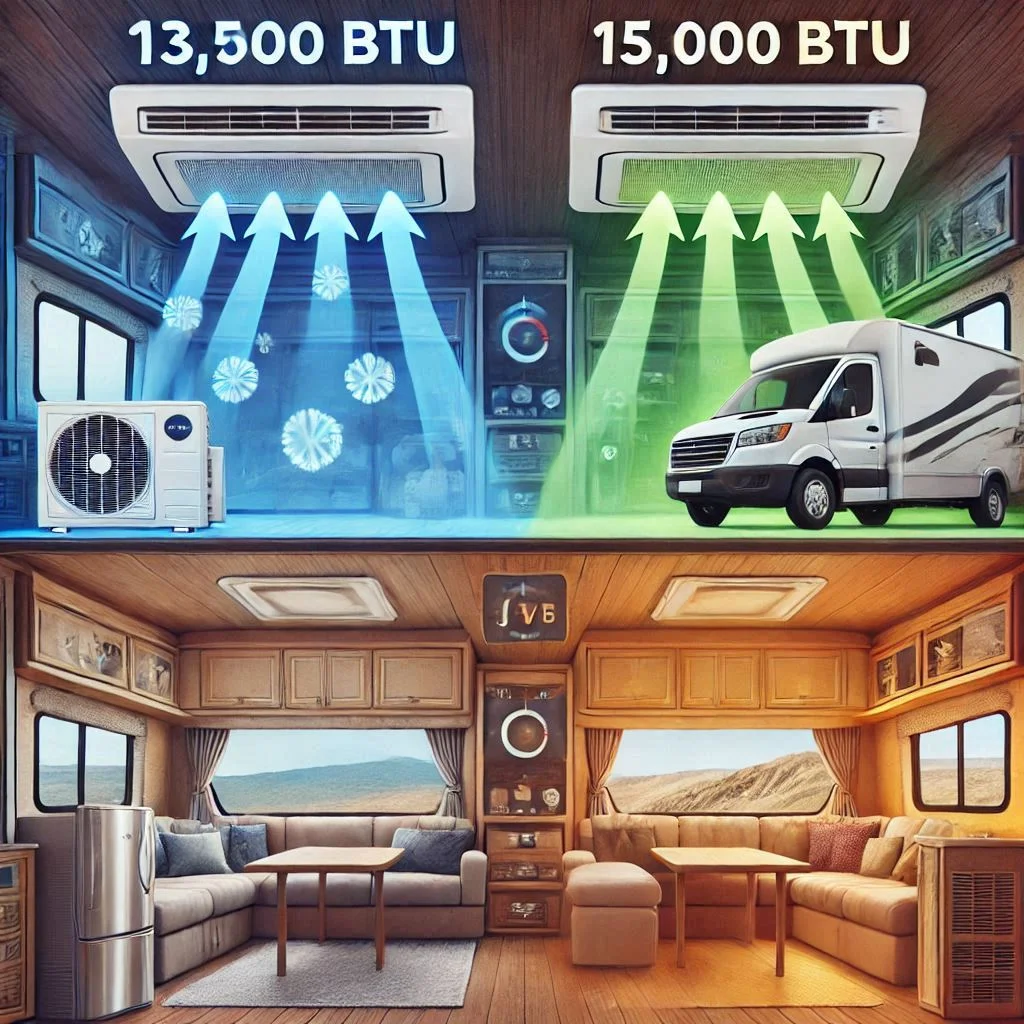
Choosing the Right Size for Your RV
Selecting the right BTU for your RV is crucial to ensure that your air conditioner operates efficiently without overworking or underperforming. Here’s how to choose the right size:
- Small RVs and Travel Trailers: If you own a small RV or travel trailer (less than 300 square feet), a 13,500 BTU air conditioner should provide sufficient cooling, even in warmer climates. It’s a balanced option for those who don’t want an overly powerful air conditioner that may lead to inefficient cooling.
- Mid-Size RVs and Fifth Wheels: For RVs between 300 and 400 square feet, a 15,000 BTU air conditioner will ensure better cooling power, especially in hot climates or when you’re parked in direct sunlight for extended periods. It will maintain a comfortable temperature without being forced to run constantly.
- Large RVs and Motorhomes: Larger RVs may require multiple air conditioners or a single 15,000 BTU unit to handle the space and ensure even temperature distribution. Choosing the correct BTU size based on your RV’s square footage is vital to avoid inadequate cooling or unnecessary energy consumption.
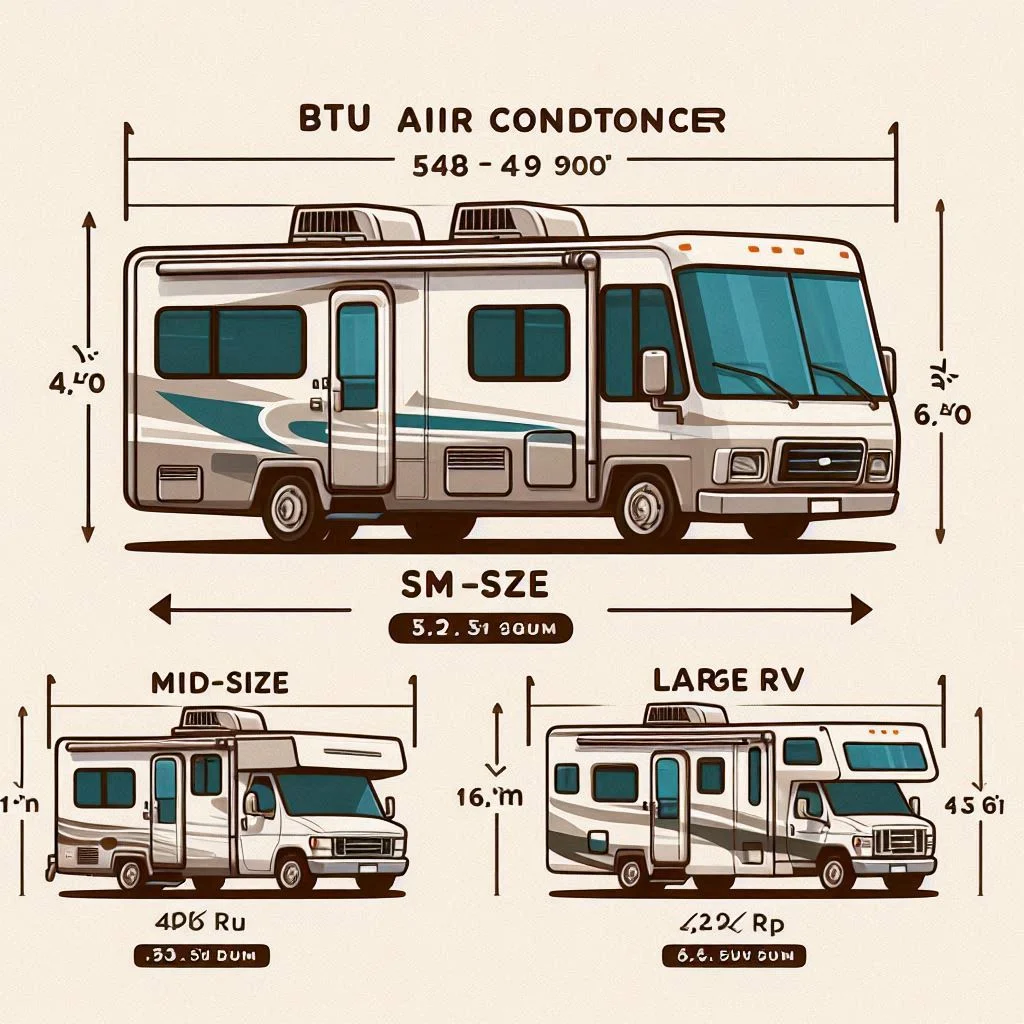
Energy Efficiency and Noise Comparison
While both 13,500 BTU and 15,000 BTU air conditioners are energy-efficient, there are some considerations to keep in mind regarding their energy use and noise output:
- Energy Efficiency:
- 13,500 BTU units tend to be slightly more energy-efficient, as they don’t need as much power to cool a smaller area. They are ideal for RV owners who are looking to conserve energy or rely on battery power for off-grid living.
- 15,000 BTU units, while still energy-efficient, will consume more power due to their increased cooling capacity. However, many newer models come with energy-saving features such as variable-speed compressors and eco-friendly refrigerants to balance performance and efficiency.
- Noise Levels:
- 13,500 BTU air conditioners are generally quieter than their 15,000 BTU counterparts. With less cooling power required, these units tend to produce less noise while operating, making them a better choice for RV owners who prioritize a quiet environment.
- 15,000 BTU air conditioners, due to their larger compressors and higher cooling capacity, can be a bit noisier. However, noise levels vary between brands and models, and some 15,000 BTU units are designed with noise-reduction technologies to minimize sound.
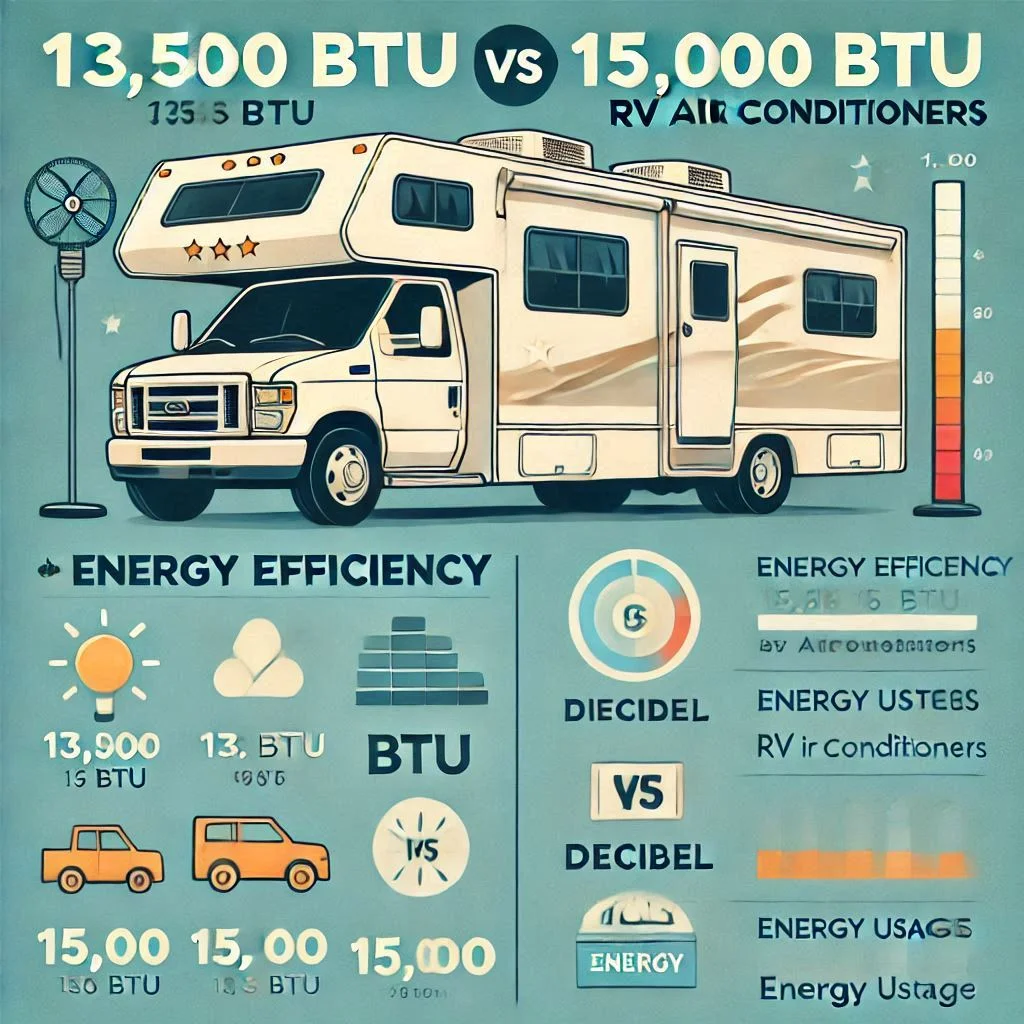
How to Calculate the Ideal BTU Size for Your RV
Choosing the right BTU size for your RV air conditioner is essential to ensure efficient cooling without wasting energy or compromising comfort. The correct BTU size ensures that your AC system is powerful enough to handle the size and conditions of your RV. Here’s how to calculate the ideal BTU size for your RV:
Size and Layout of Your RV
The first factor in calculating the ideal BTU size for your RV is the size and layout of the space. Larger RVs require more cooling power, while smaller RVs need less. To begin, measure the square footage of your RV. This is the most basic step to calculating the BTU size.
- Why It’s Important: The size of your RV determines how much air the AC unit needs to cool. Larger RVs, such as motorhomes or fifth wheels, require a higher BTU rating because they have more space that needs to be cooled. On the other hand, compact trailers or vans need smaller units to avoid wasting energy and overcooling the space.
- How to Calculate: Measure the length and width of the living area of your RV to find the total square footage. For example, a 300-square-foot RV might need around a 13,500 BTU air conditioner, while a 400-square-foot RV would likely require 15,000 BTUs or more.
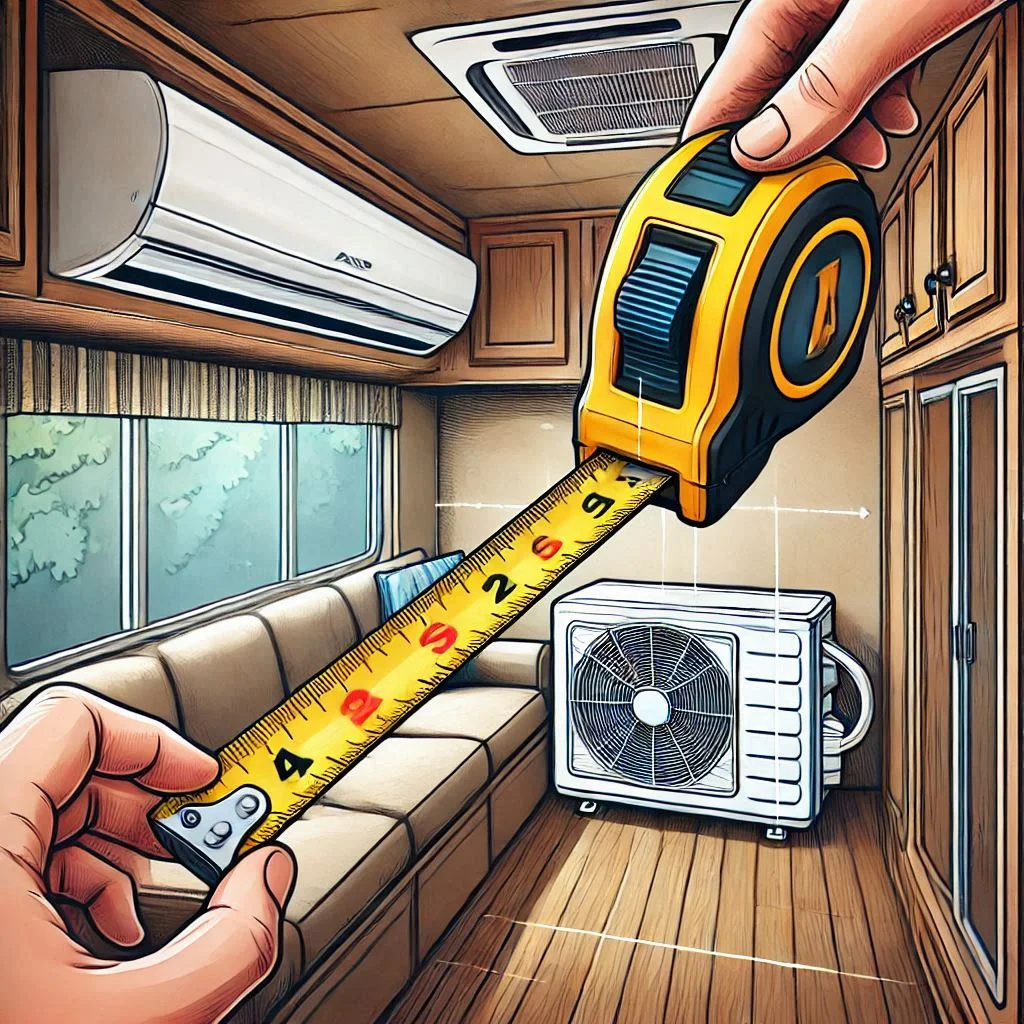
Impact of External Temperature and Humidity
Another critical factor in determining the right BTU size is the external temperature and humidity of the location where you’ll be camping or parked. Warmer climates with high humidity levels demand a more powerful air conditioner to maintain a comfortable indoor temperature.
- Why It’s Important: Air conditioners not only cool the air but also remove moisture. In hot, humid environments, the air conditioner works harder to reduce both temperature and humidity. The higher the temperature and humidity, the more cooling capacity you’ll need from your AC unit.
- How to Calculate: The general rule is to add 2,000 BTUs for each additional 100 square feet of space if you’re in a particularly hot or humid area. For example, if your RV is located in a hot and humid climate, a 15,000 BTU unit might be better for a 300-square-foot space.
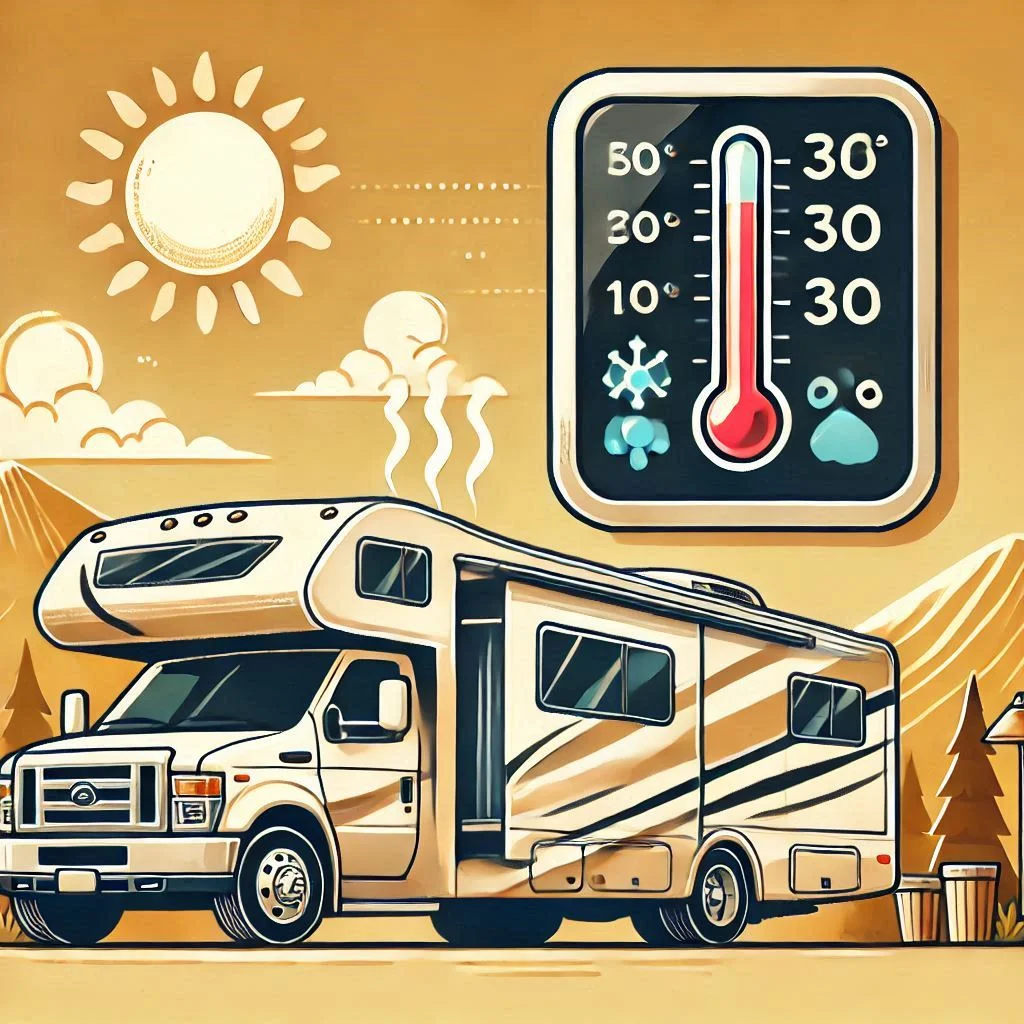
Insulation Quality and RV Design
The insulation quality of your RV plays a huge role in how well it maintains the temperature inside. Well-insulated RVs require less cooling power to maintain a comfortable indoor environment. Conversely, RVs with poor insulation or older designs may require more cooling capacity, even in milder conditions.
- Why It’s Important: Good insulation reduces the load on the air conditioner by preventing heat from entering or escaping. RVs with poor insulation need larger, more powerful air conditioners to compensate for this loss of thermal efficiency.
- How to Calculate: If your RV has better insulation (e.g., double-pane windows, thick walls), you may be able to choose a slightly smaller unit for the same square footage. On the other hand, if your RV has minimal insulation or is an older model, you may need to go up in BTU size for adequate cooling.
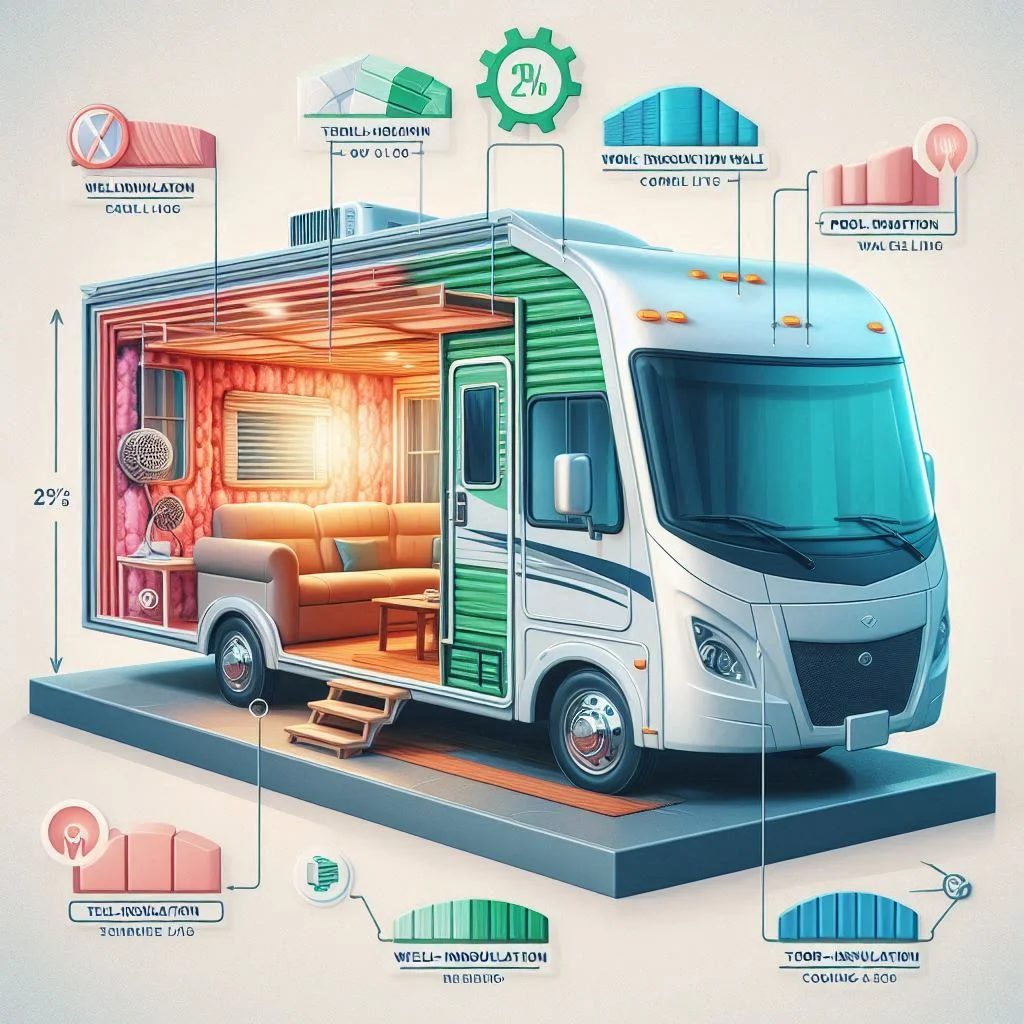
What Affects the Power Usage and Efficiency of Your RV AC?
The efficiency of your RV’s air conditioner plays a significant role in how much power it uses, and understanding what affects its power usage can help you make smarter decisions when choosing or maintaining your AC system. Several factors, such as wattage, amperage, external temperature, RV size, and insulation quality, influence the overall power consumption and efficiency of your RV’s AC. Here’s an in-depth look at these factors:
Understanding Watts and Amperage
Before diving into the factors that affect power usage, it’s important to understand the basics of how power is measured in RV air conditioners:
- Watts: Watts (W) refer to the amount of power an RV air conditioner uses to operate. This is the energy consumed by the AC to cool your RV effectively. The more watts an air conditioner consumes, the more electricity it needs to function. Typically, RV air conditioners will have a wattage rating that helps you determine how much power they consume.
- Amperage: Amperage (amps) is another important measurement to consider. It tells you the amount of electrical current the air conditioner requires to function. Amps are closely related to watts since the more amps an AC uses, the more watts it consumes.
Understanding both watts and amperage helps you assess how much electricity your RV’s air conditioner will consume from your RV’s power source, whether that be from shore power, a generator, or your RV’s battery.
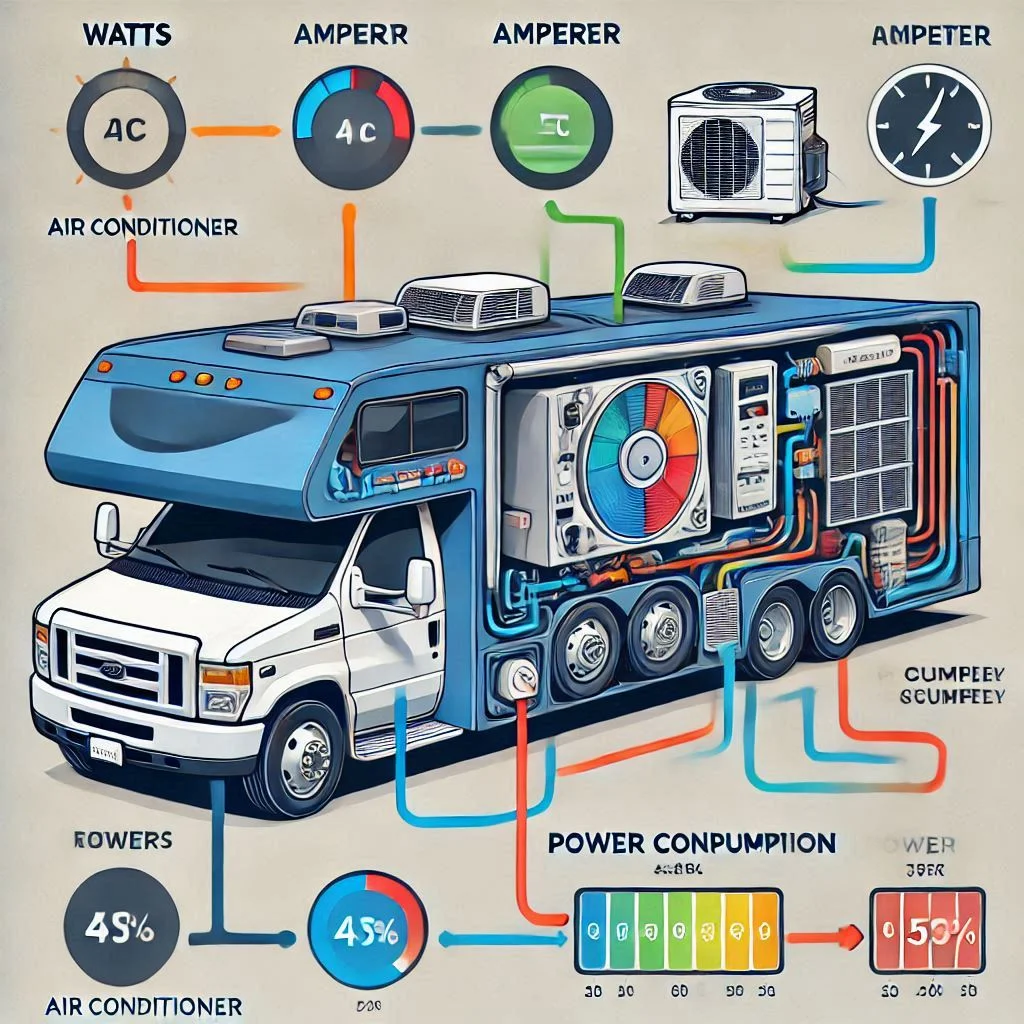
Factors Affecting Wattage Consumption
Several factors determine how much power your RV air conditioner will consume. These factors include the ambient temperature, size of your RV, and the insulation quality of your RV. Let’s break them down:
1. Temperature
External temperature plays a major role in the wattage consumption of your RV air conditioner. The hotter the external temperature, the harder your air conditioner will need to work to cool down your RV. This means it will consume more watts to maintain a comfortable indoor temperature.
- Hotter Environments: In extreme heat, your AC will need to run longer and work harder to cool down the RV, leading to increased wattage consumption. In very hot climates, consider investing in a more energy-efficient AC unit or a higher BTU unit that can handle the workload without overstretching its limits.
- Milder Climates: If you’re traveling in cooler environments, your AC won’t have to run as frequently, consuming less power. However, even in mild conditions, an air conditioner may still need to operate during the day or at night, consuming a consistent amount of energy.
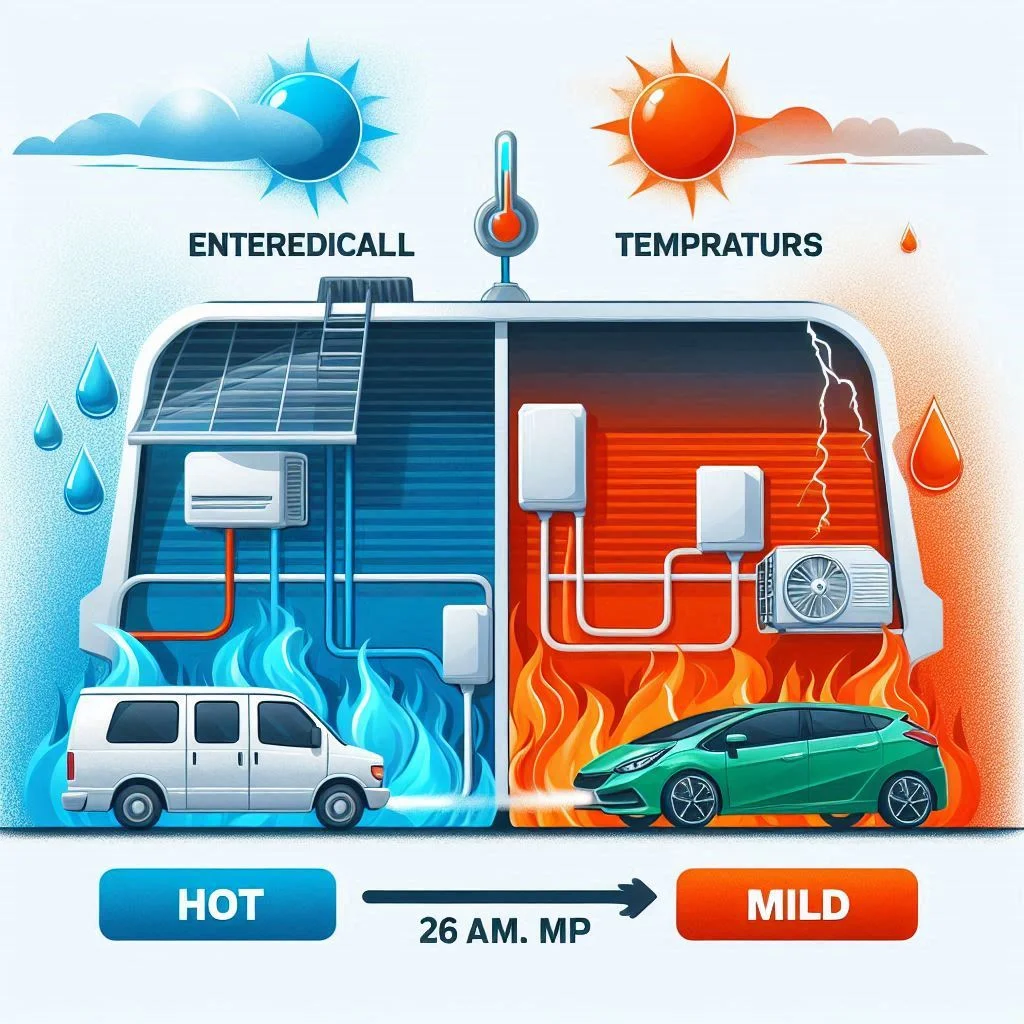
2. RV Size
The size of your RV significantly affects the wattage consumption of your air conditioner. Larger RVs require more cooling power to maintain a comfortable temperature, which leads to higher power usage. A larger air conditioner with a higher BTU rating will consume more watts compared to a smaller unit in a compact RV.
- Small RVs: For smaller RVs, a 13,500 BTU air conditioner will generally suffice, and it will consume less power (fewer watts). These smaller units are more energy-efficient, as they don’t need to cool a larger space.
- Large RVs: For large RVs or motorhomes, a 15,000 BTU or higher air conditioner will be required to cool the entire space. These units will consume more power, especially if the RV has multiple rooms or open spaces that require consistent cooling.
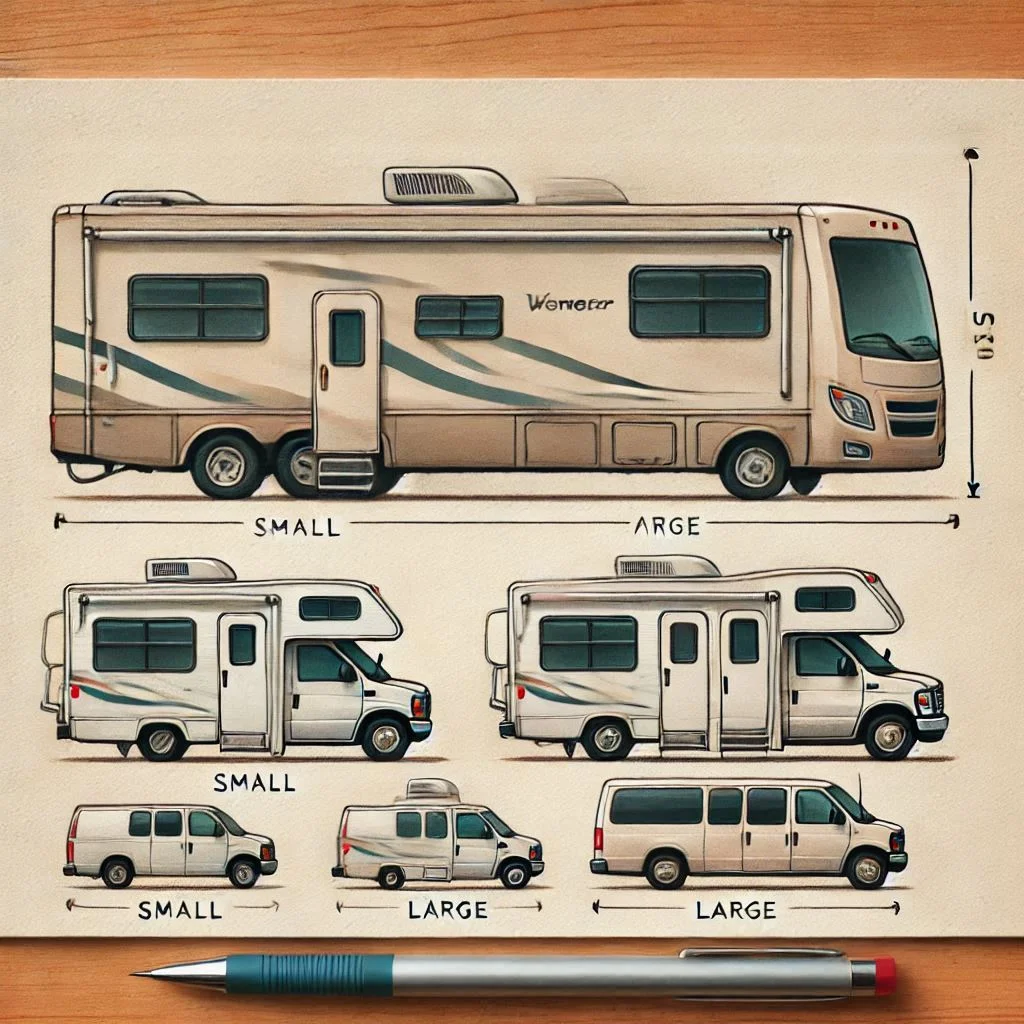
3. Insulation Quality
Good insulation helps your RV maintain a stable indoor temperature, reducing the workload on your air conditioner and subsequently lowering power consumption. Poor insulation, on the other hand, causes the AC to work harder as the temperature fluctuates inside, leading to higher wattage usage.
- Well-Insulated RVs: RVs with high-quality insulation (double-pane windows, thick walls, etc.) can retain cool air better, leading to more efficient cooling. Your air conditioner doesn’t have to run constantly, reducing overall power usage.
- Poorly Insulated RVs: In RVs with inadequate insulation, the air conditioner has to work harder to maintain the temperature, which results in higher wattage consumption. If your RV is older or lacks proper insulation, it’s advisable to consider upgrading the insulation to save on energy costs.
FAQS:
What Does BTU Stand For?
BTU stands for British Thermal Unit, which is a measure of energy used to describe the amount of heat an air conditioner can remove from the air. In the context of RV air conditioners, BTUs are used to measure the cooling capacity of the unit. The higher the BTU rating, the more cooling power the air conditioner has, and thus, the larger the space it can effectively cool.
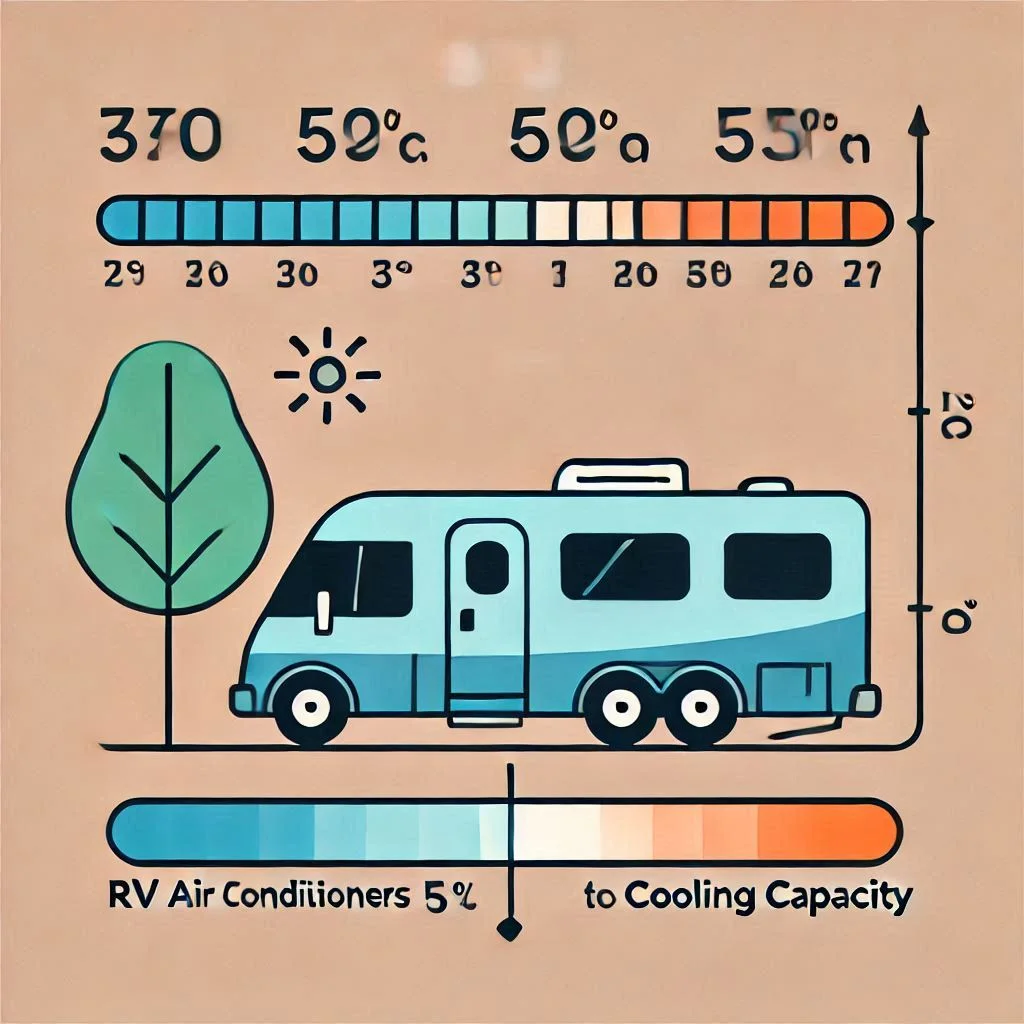
Does a Higher BTU Rating Mean Better Cooling or Heating Performance?
Yes, a higher BTU rating means better cooling performance, but it’s important to select the right BTU size based on your RV’s space. If you choose an air conditioner with a BTU rating that is too high for your RV, it might cool the space too quickly without adequately removing humidity. On the other hand, an AC with too low a BTU rating might struggle to cool the RV effectively, especially during hot weather.
- Higher BTU: This is ideal for larger RVs or when traveling to warmer climates, as it ensures that your AC can handle the extra load and efficiently cool your RV.
- Lower BTU: More suited for smaller RVs or cooler environments, as it provides enough cooling without wasting energy.
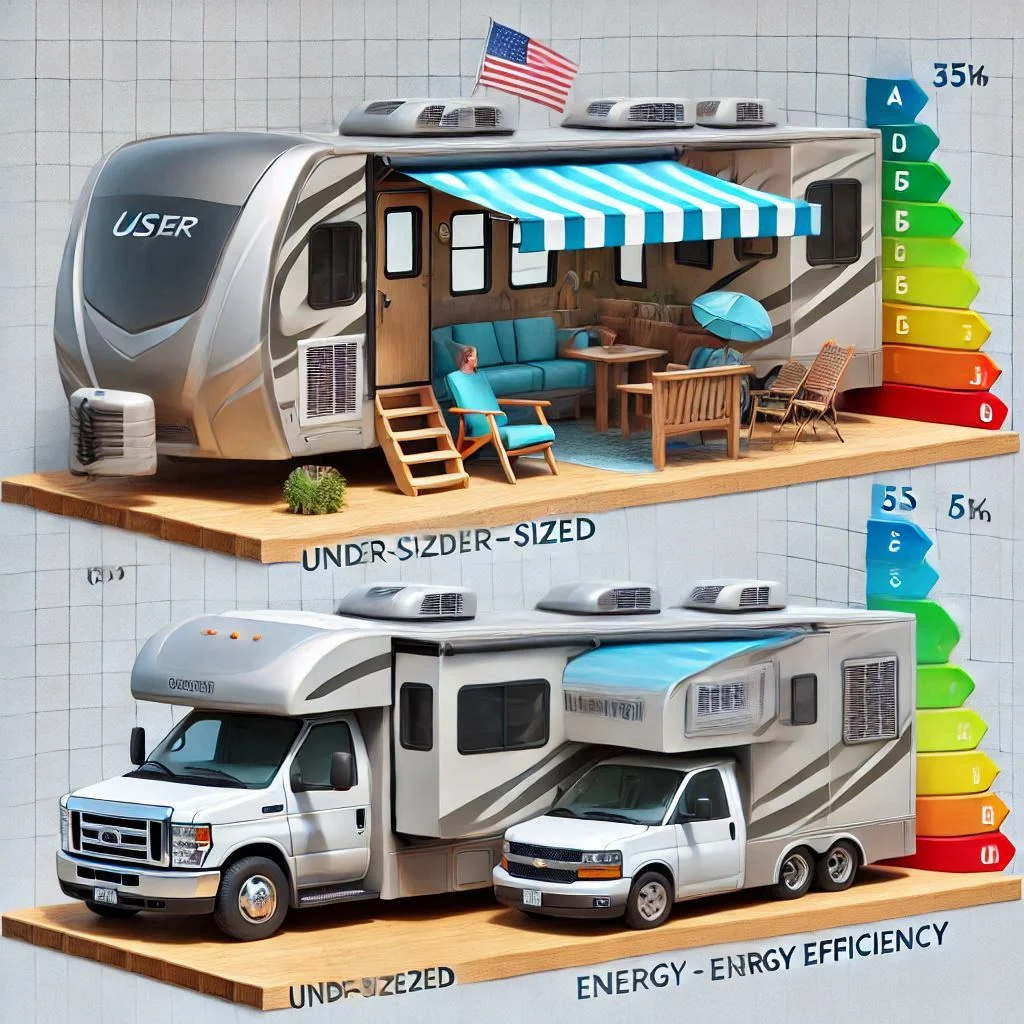
How Do I Know If I Need a 13,500 or 15,000 BTU RV Air Conditioner?
To determine whether you need a 13,500 BTU or 15,000 BTU air conditioner for your RV, consider the following factors:
- Size of Your RV: A 13,500 BTU unit is typically enough for RVs up to 300 square feet. However, if your RV is larger than that or if you frequently travel to very hot or humid climates, a 15,000 BTU unit would be a better fit.
- Climate: In warmer or more humid climates, you’ll likely need more cooling power to maintain a comfortable temperature. The higher BTU will allow the air conditioner to cool the space more effectively, even when it’s extremely hot outside.
- Energy Efficiency: The larger the AC unit, the more watts it will consume. If you’re concerned about energy efficiency, carefully balance the BTU size with the energy needs of your RV. Over-sizing an air conditioner can waste energy, especially in cooler temperatures.
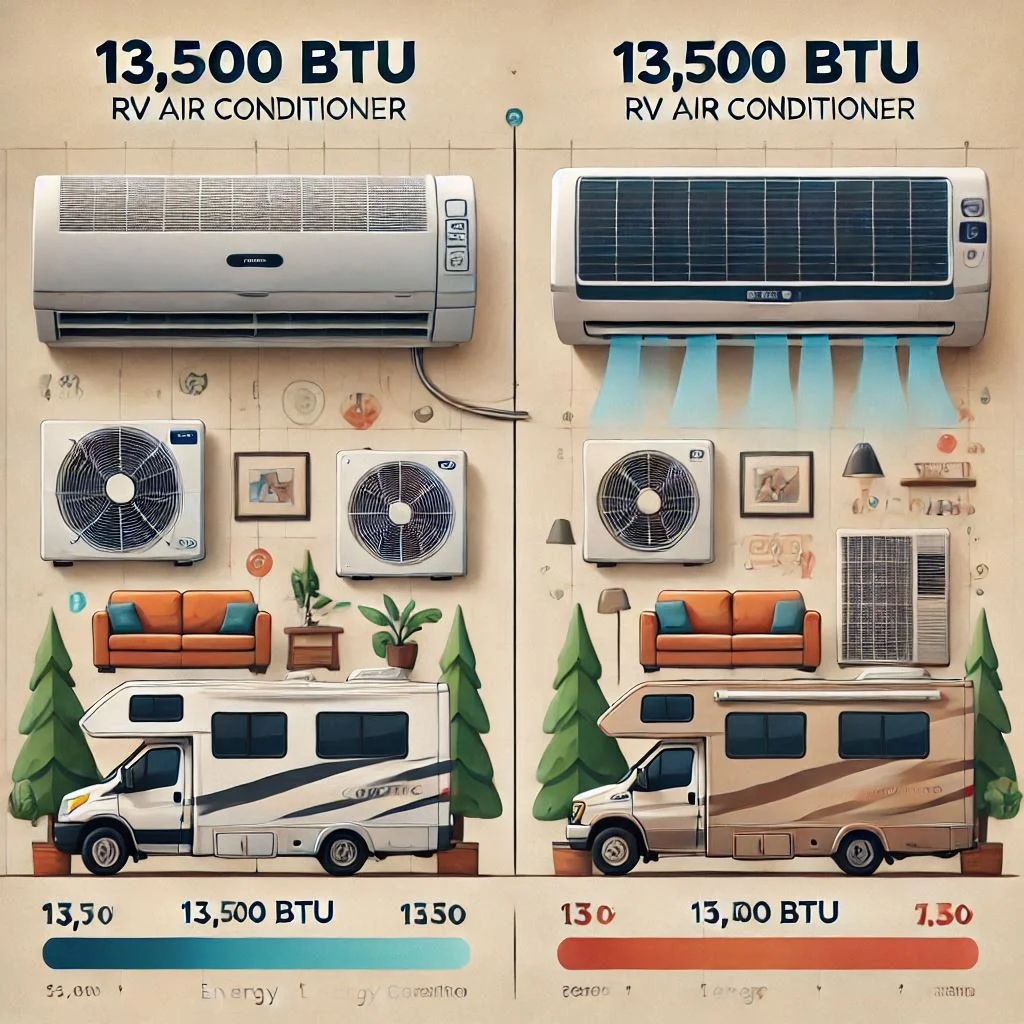
Are There Energy Efficiency Differences Between 13,500 and 15,000 BTU Units?
Yes, there are energy efficiency differences between 13,500 BTU and 15,000 BTU units, although the difference may not be significant in some cases. The main factors affecting efficiency are:
- BTU Size: A 15,000 BTU unit uses more electricity than a 13,500 BTU unit due to its higher cooling capacity. However, the larger unit will run less frequently, as it cools the space more quickly, potentially balancing out the increased power consumption.
- Energy-Efficient Models: Look for energy-efficient models with EER (Energy Efficiency Ratio) ratings to get a better understanding of their power consumption relative to their cooling output. Higher EER ratings indicate better efficiency.
- Climate Consideration: In extremely hot environments, the 15,000 BTU may actually prove more energy-efficient because it will run for shorter periods, while a smaller AC unit may need to work harder and longer to cool the same space.
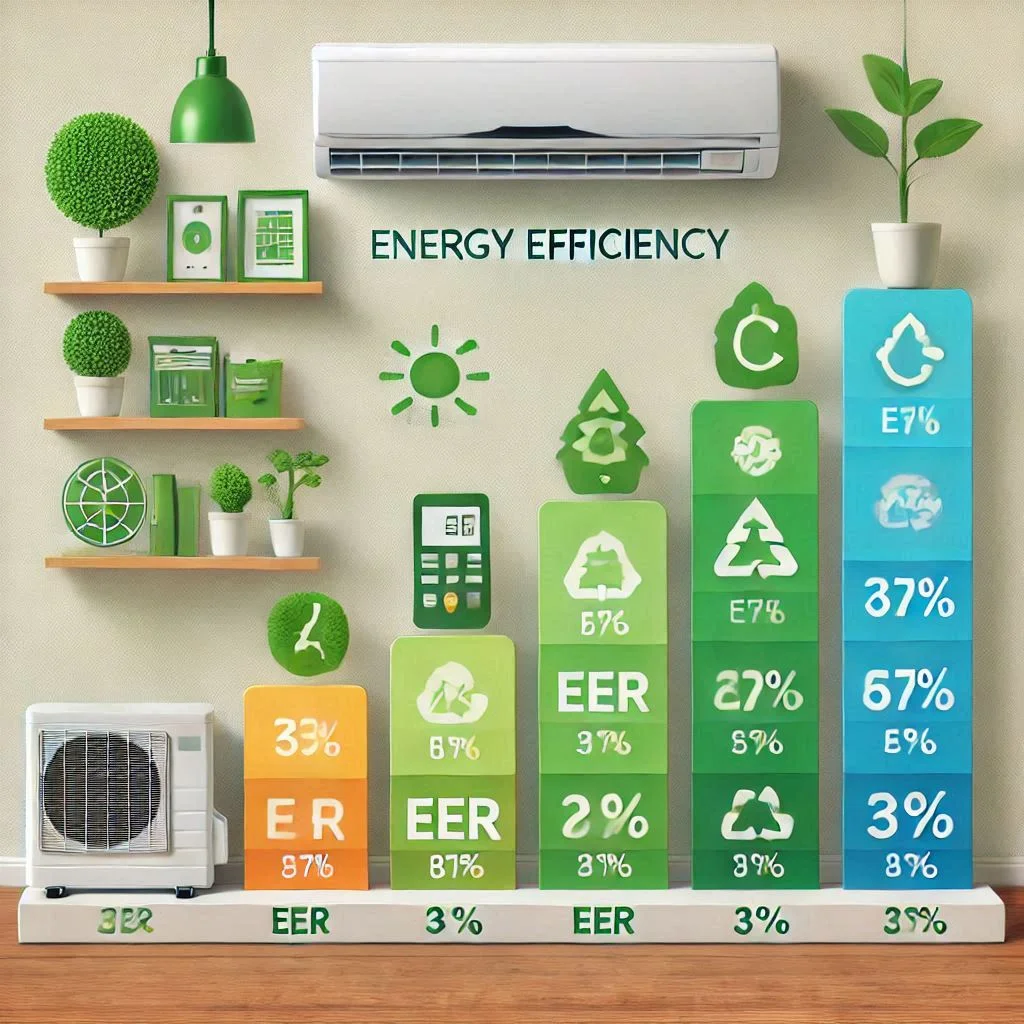
Are There Noise Differences Between 13,500 and 15,000 BTU Air Conditioners?
Yes, there can be noise differences between a 13,500 BTU and a 15,000 BTU air conditioner. In general:
- Larger Units (15,000 BTU): These units can be slightly louder due to their higher capacity and the need to expel more air to cool the space. The fan speed is often higher in these models, which can contribute to the noise level.
- Smaller Units (13,500 BTU): These units tend to be quieter as they don’t have to work as hard to cool the space, leading to less airflow and reduced noise levels. However, the difference in noise levels isn’t usually significant unless you’re particularly sensitive to noise.
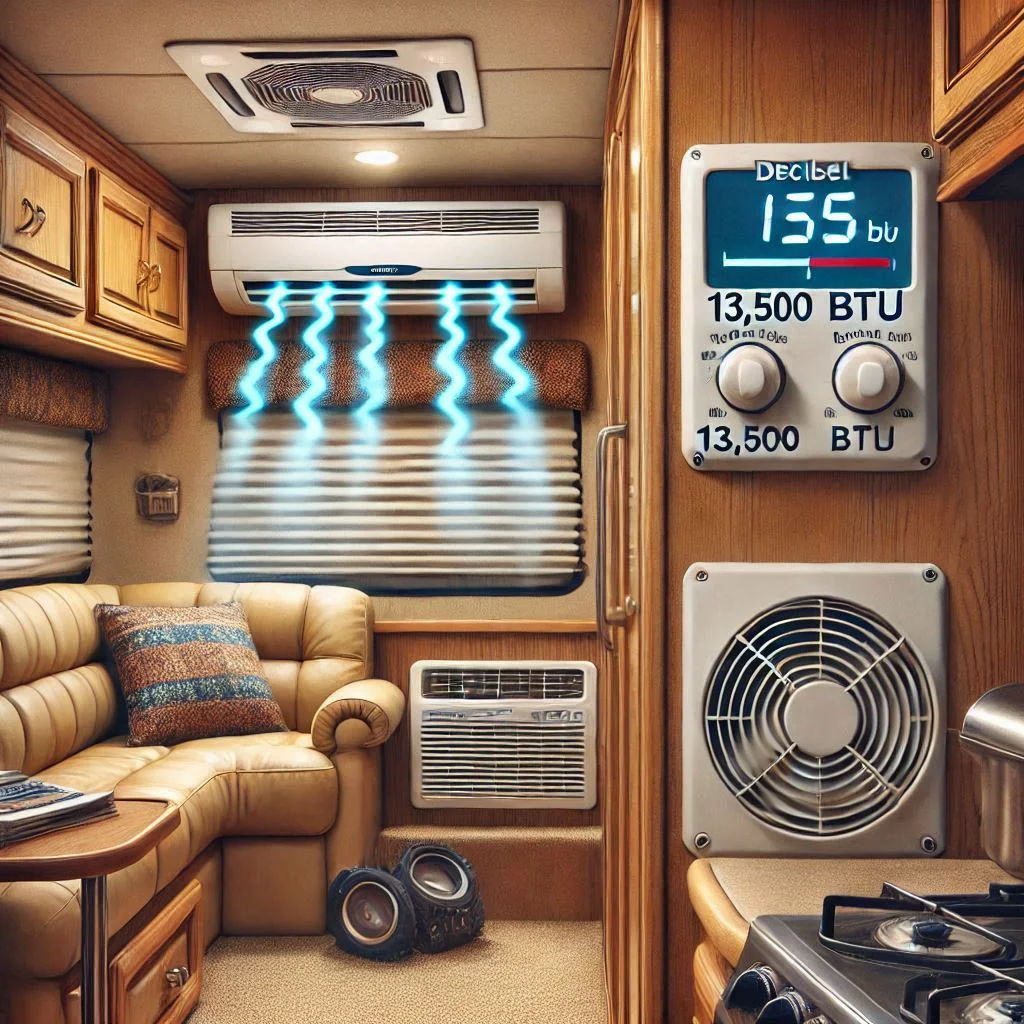
Conclusion:
In conclusion, understanding the BTU rating and power usage of your RV air conditioner is crucial for making an informed decision when it comes to cooling your RV efficiently. By considering factors like the size of your RV, climate conditions, insulation quality, and energy consumption, you can select the right air conditioner to ensure comfort while minimizing energy costs. Whether you’re deciding between a 13,500 BTU and 15,000 BTU unit or calculating the wattage usage for your specific setup, taking the time to assess these variables will help you make the best choice for your RV. With the right AC unit, you’ll enjoy a cooler, more comfortable journey—no matter where the road takes you.
By following these guidelines and utilizing tools like spec sheets, amperage checks, and comparing cooling capacities, you can make the most out of your RV air conditioning system. If you’re still unsure, don’t hesitate to consult with an RV technician or specialist to find the optimal solution tailored to your needs. Happy travels and stay cool!

